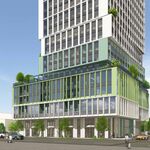- Rather than allowing Toronto’s existing Sheppard “stubway†to languish because it goes nowhere (and thus attracts poor ridership), it should be extended east immediately to meet the proposed Downtown Relief Line. Eventually, it also should be extended west to meet the University/Spadina subway being extended up into Vaughan to close the loop and create a larger network. --- This is what engineers call “essential redundancyâ€: It provides an alternative during the inevitable breakdowns and closures for scheduled maintenance. But more would be needed. The under-construction Eglinton Crosstown LRT — along with an LRT on Steeles — would create an efficient cross-linked transit system to serve the central GTA for decades to come.
I agree with the Eglinton LRT and Steeles LRT ideas. It makes more sense to link up the DRL with Don Mills station than to go east to Victoria Park, though.
[- Looking beyond John Tory’s SmartTrack proposal to electrify an existing GO Transit Corridor, and provide east-west service to Union Station, city planners should consider the benefits of a completely new east-west subway line under Queen Street. This idea was proposed by the Toronto Transit Commission in the 1960s, along with a streetcar elimination program. However, a vocal and well-organized group known as “Streetcars for Toronto†managed to kill the idea. These hippies are responsible for much of today’s mobility challenges and downtown traffic chaos.
Anddddd we're done. A few counterpoints:
1) the Queen subway was supposed to be the original east-west subway line, proposed in 1942. Bloor won out for political reasons.
2) The Queen subway remained on the books and was repeatedly ignored in favour of different suburban subways (the Spadina line was built instead of Queen in the 1960s, then of the network 2011 (proposed 1985) proposal, which included a DRL, the Eglinton and Sheppard stubs were built instead).
3) "Streetcars for Toronto" was against the streetcar elimination program. They had nothing to do with subways. I am pretty sure this is just meant to be a dig at Steve Munro for having so roundly demolished the good Dentist's confused forays into public transit.
- - Transit lines could be located more uniformly between Bloor and the waterfront, decongest current flow patterns and deconcentrate the current development in the financial district to locations north of the existing core. A Queen line would better serve the retail, healthcare (four major hospitals are located between Queen Street and College Street) and the university district. Farther along Queen at Bathurst, Toronto Western Hospital is located at Dundas and Bathurst. A Queen line extending farther east and west could take the pressure off both the Yonge/University/Spadina line and the Bloor/Danforth line.
What a flimsy justification for a Queen alignment. If you're going to argue for a DRL you shouldn't start off by defending your pet alignment. Also, how do you argue for a Queen alignment and not mention the fact that there are provisions for a subway beneath Queen and Osgoode stations? Maybe because you're a dentist without any knowledge about Toronto transit.
- Queen Street between Bay Street and York could be closed, and the existing Nathan Philips Square could be extended to encompass Queen Street and create a large, friendly, attractive urban meeting place. The Queen subway stations extending west from Yonge and east from University could be connected by an underground tunnel and mall with an iconic pavilion in front of City Hall. Bringing light down into the station and connection would create an engaging, people-friendly space above and below ground similar to the transit pavilion at the new World Trade Centre in New York.
This sounds like more justification for a Queen street
transit mall than for a subway running underneath. A transit mall would be great for creating an "engaging, people-friendly space".
- The Queen line should be extended east to Woodbine/Kingston Rd. and then up Victoria Park to meet the Sheppard East extension. The Queen line also should be extended west to the Queensway through Parkdale and up Keele St. Thus, a continuous subway loop would be created (once Sheppard is extended west), which in turn would act as the anchor and link for the other lines — similar to systems in Paris and other European cities.
Ugh, what an awful fantasy alignment. Are we relieving the Yonge line or the Bloor-Danforth line? Also, does someone have a graphic of his fantasy map? I'm not sure what he's talking about with "West to the Queensway and up Keele street" when the two don't intersect.
This annoys me. The National Post could interview any of the random internet posters here on UT and get a more credible fantasy map.
- The controversial extension of the Bloor/Danforth subway, if the subway option prevails, should be extended from Kennedy Station to McCowan Road. The subway would then extend up McCowan to the Scarborough Town Centre, run parallel to Highway 401 to Centennial College, then up McCowan Road to a terminal station at Steeles Avenue, where it would connect with the Steeles LRT line. This alignment would allow continued operation of the current Scarborough Rapid Transit system during periods of construction, and integrate well with the proposed subway line along Victoria Park to provide acceptable transit coverage to Scarborough.
At least all his lines connect.
.....




